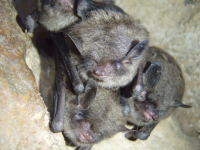Duke, Cherokee meeting opens dialogue over Kituwah site
After a day of discussions between the leadership of Duke Energy and the Eastern Band of Cherokee Indians, the dispute over the construction of a proposed power substation near the tribe’s most sacred site remains unresolved.
Last Wednesday (Feb. 17) Brett Carter, President of Duke Energy Carolinas, led a delegation to the EBCI Council House to meet with members of the tribal council and Principal Chief Michell Hicks. The meeting was billed as a closed-door discussion between leadership of the two entities, but before it began a group of demonstrators expressing support for the tribe’s leadership was invited inside.
What followed was, according to participants, a formal and orchestrated dialogue in which Carter expressed his regret that Duke Energy had not consulted with the tribe before beginning the site preparation for the substation. But while Duke has admitted to poor communication and expressed a willingness to pursue mitigation of the visual impact of their project, they have also continued to work on preparing the site for construction.
“The work that’s going on at the site is grading and prep work, and that work is going to continue,” said Duke spokesperson Jason Walls.
While the tribe wants to see the substation moved to another tract, Duke asserts the visual impacts can be mitigated.
After the discussion between Carter and the members of the Tribal Council had finished, the council allowed a series of questions from the audience. Some were probing and others impassioned, but all of the tribal members who showed up wanted to make it clear visual mitigation wasn’t enough; they wanted the substation and line upgrade project moved off the hill.
Natalie Smith, a tribal member and Cherokee business owner who helped organize the demonstration, said she was grateful to the council for inviting them into the dialogue.
“You can’t do this here,” Smith said. “That was the bigger message.”
Chief Hicks also invited members of the Swain County board to the table. Swain County Commissioner David Monteith was not impressed with Duke’s communication with the leadership of the county or the tribe.
“I think they treated Swain County like a left-handed stepchild,” Monteith said. “Professional courtesy from a company of the size of Duke with a project that large would at least tell you to talk to the commissioners.”
George Wickliffe, a chief of the Oklahoma Cherokee United Keetoowah Band, sat in on the meeting, too.
“Kituwah is well documented as our Mother Town and due to its history, not only through such documentation, but orally and as a part of our religious tradition, is like the Garden of Eden to the Christian,” said Wickliffe.
After the meeting, Hicks said the tribe had already identified areas that could be used as alternative sites for the substation, but he wouldn’t comment on whether any definite alternatives had already been discussed.
“We’re still working on what our options are,” Hicks said. “I think they were sincere about the failure to notify us of the project. As far as negotiating, we won’t know until we see what options they present.”
Hicks said over the next two weeks Duke would submit plans to minimize the visual impact of their project, and the EBCI would offer Duke options for moving the site off the hillside.
Walls called the meeting “productive” and said Duke “left with a commitment to work on additional mitigation to minimize the visual impact” of the project.
Report shows Duke considered impact on Kituwah
In the wake of the controversy surrounding the company’s proposed substation, Duke Energy representatives claimed they were unaware of the project’s potential impact on the Cherokee’s most valued site.
But Russ Townsend, historic preservation officer for the Eastern Band of Cherokee Indians, isn’t so sure. Townsend received an archeological report that Duke conducted on the site of the substation in 2008.
“It basically clarified that Duke did know all of these things they were saying they weren’t aware of,” Townsend said. “That was disappointing. They’re not required by law to consult with me, but they’ve always said they wanted to be a good neighbor.”
Archeologically, the substation project’s interference with Kituwah presents an interesting dilemma.
The EBCI bought 309 acres around the mound site in 1996, and an archeological survey the following year discovered a 65-acre village site that confirmed a long term of settlement. The mound site and the surrounding village are listed separately on the federal register of historic places.
The mound, 170 feet in diameter and five feet tall, formed the base for the council house where the Cherokee conducted some of their most sacred ceremonies.
The Duke substation project is taking place on a surrounding hillside that is not owned by the tribe. Duke considers the project an upgrade of an existing line, and therefore is not bound to a public vetting process that would involve consulting with state historic preservation officials. The substation site covers a 300 by 300 foot square, and its structures will be 40-feet high.
But the Cherokee have argued the project directly threatens the integrity of the Kituwah site.
Tom Belt, who teaches Cherokee language and culture at Western Carolina University, explained that the concept of the Kituwah mothertown for the Cherokee would encompass the entire area within a day’s walk of the council house. Belt said the actual valley and its mountains play crucial roles in spiritual ceremonies held on the solstices and in the cosmology that support the tribe’s clan structure.
“On those days if you stand at the mound where the council house was, the very place the light hits first is on the seven peaks on that mountain where the substation will be built,” Belt said.
Townsend said the archeological report filed by Duke confirmed there were 15 important sites within a mile of the substation project, and two nationally registered sites within a half mile. Townsend said there are likely no artifacts left in the ground in the area, but the report, conducted by a private firm, leaves little doubt about its archeological significance.
“It’s my professional opinion that this is really a true adverse impact to Kituwah,” Townsend said. “It’s not just a site on a hill we don’t want developed.”
Duke Energy president agrees to meet with Cherokee chief
A disagreement over Duke Energy’s placement of a power substation near Cherokee’s most significant cultural site has instigated a meeting between the top leaders of the tribe and the company.
Principal Chief Michell Hicks, the tribal council, and the attorney general of the Eastern Band of Cherokee Indians are set to meet with Duke Energy Carolinas President James Rogers behind closed doors on Wednesday (Feb. 17) to discuss the issue.
Hicks said he wanted to wait until after the meeting to discuss whether negotiations would involve visual mitigation of the substation or moving the project entirely.
“We want the land protected, and we want the viewshed protected,” Hicks said. “I don’t know where they’re at. Until I sit down with the president and hear where they’re coming from, I don’t want to comment on that.”
The ECBI owns a 309-acre Kituwah mound site, which was historically the tribe’s spiritual and political center. But it does not own the surrounding hillsides where the substation is slated to go.
In November, Duke began bulldozing part of a mountainside tract near the Hyatt Creek/Ela exit off the Smoky Mountain Expressway between Cherokee and Bryson City to prepare for construction of the substation. The mountainside is considered by the Cherokee to be a part of the greater Kituwah mothertown. Should the project move forward, it would mar a viewshed integral to the tribe’s cultural identity.
The EBCI’s tribal council passed a resolution authorizing Principal Chief Michell Hicks to seek outside legal counsel to attempt to prevent Duke from moving forward with the substation and a transmission line expansion near the Swain County site during its meeting on Feb. 4.
Since then, work at the site has continued. Some 15 members of the tribe traveled to the Swain County commissioners meeting last week in order to ask the board to join with the tribe in opposing the Duke project. The commissioners took no formal action.
“We don’t have any ordinance or regulatory authority to cover that,” said Chairman Glenn Jones. “If the Cherokee want to bring a lawsuit or whatever, we told them we would probably be willing to put our name to it.”
Representatives from Duke have said the substation and line upgrade was intended to serve the expanding demand for energy created by the growth of Harrah’s Cherokee Casino.
Company spokesperson Paige Layne cited a lack of communication over the issue as the point of tension.
“This was not something we initiated to cause harm,” Layne said. “Our goal was to provide energy to our consumer base. I guess the next step is to make sure we’re doing that with the utmost respect to the tribe’s culture.”
Wednesday’s meeting could clear the air, but it could also solidify differences between the tribe and the utility company.
Duke has already expressed its intent to resolve the issue through a plan to mitigate the visual impact of the substation on the mountainside. But the tribal council’s resolution cleared the way for a legal battle that could play out in the form of hearings before the North Carolina Utility Commission.
What is Kituwah?
Kituwah is a concept much larger than the mound site proper, which is recorded with the state register of historic places. The name signifies the mothertown of the Cherokee, a kind of original community with which all Cherokees identify.
“The boundaries of Kituwah aren’t confined to the area. It’s intrinsic to the heart and soul of the Cherokee people,” said Tom Belt, a professor of Cherokee Language and Culture at Western Carolina University.
Belt explained Cherokees as far west as Memphis would have identified themselves as Kituwah during the 1600s.
But the tribe lost control of the Kituwah village in the years preceding their forced removal from their ancestral land in Western North Carolina.
During most of the last century and a half, the land has been under agricultural cultivation as part of a tract called Ferguson’s Field.
The Eastern Band bought 309 acres around the mound site in 1996, and an archeological survey the following year discovered a 65-acre village site that confirmed the long term of settlement.
The mound, 170 feet in diameter and five feet tall, formed the base for the council house where the Cherokee conducted some of their most sacred ceremonies.
Belt explained that the concept of the Kituwah mothertown for the Cherokee would encompass the entire area within a day’s walk of the council house. But Belt said the actual valley and its mountains play crucial roles in spiritual ceremonies held on the solstices and in the cosmology that support the tribe’s clan structure.
“On those days if you stand at the mound where the council house was, the very place the light hits first is on the seven peaks on that mountain where the substation will be built,” Belt said.
Duke project threatens sacred character of Kituwah site
The Eastern Band of Cherokee Indians may pursue legal action against Duke Energy after learning about the utility company’s plans to put an electric substation near Kituwah mound, the tribe’s most sacred site.
On Friday the EBCI’s tribal council passed a resolution authorizing Principal Chief Michell Hicks to seek outside legal counsel to attempt to prevent Duke from moving forward with the substation and a transmission line expansion near the Swain County site.
“I’m very disappointed with the lack of contact with Duke on such a large facility being built near our most important site,” Hicks said.
Hicks said he learned about the estimated $79 million project –– which he termed a “desecration”–– in late December and voiced his concerns to Duke’s regional manager, Fred Alexander. The ensuing discussions were limited, Hicks said.
In November, Duke began bulldozing part of a mountainside tract near the Hyatt Creek/Ela exit off the Smoky Mountain Expressway between Cherokee and Bryson City to prepare for construction of the substation. The mountainside is considered by the Cherokee to be a part of the greater Kituwah mothertown, which was once the tribe’s spiritual and political center. Should the project move forward, it would mar a viewshed integral to the tribe’s cultural identity.
Duke Spokesperson Paige Layne said the company was surprised about the concerns over the substation, which she said is being constructed in part to service Harrah’s Cherokee Casino.
“This was not something we initiated to cause harm,” Layne said. “Our goal was to provide energy to our consumer base. I guess the next step is to make sure we’re doing that with the utmost respect to the tribe’s culture.”
Layne said Duke Energy’s president, James Rogers, has scheduled a meeting on Feb. 22 to visit the site and to discuss the matter with Hicks.
Poor communication
The controversy over the construction of the substation emerged when the tribe’s administrators became aware of the scope of the project in late December. Duke Energy purchased the mountainside site in 2008 and a report of the Edison Electric Institute issued in January of the same year identified the Hyatt Creek Substation project as part of a larger $79 million transmission line upgrade that would nearly triple the voltage capacity on 17.5 miles of transmission line from 66 kV to 161kV.
When bulldozing work began late last year as part of the site preparation work, some of the tribe’s employees inquired about the project. The tribe’s legal office contacted the North Carolina Utilities Commission to find out what was going on.
Thomas McLawhorn, spokesperson for public staff at the commission, explained that Duke determined they did not need to file an application for the project.
“Duke has not filed an application, and I don’t believe they intend to,” McLawhorn said.
McLawhorn explained that Duke’s staff had determined that the upgrade project did not require an application under general statute 62.101, which governs the construction of transmission lines.
According to Hannah Smith, an attorney for the tribe, utility companies are required by the statute to notify a number of state agencies and file an application whenever lines of 161kV or more are involved.
McLawhorn said Duke made the determination that, as an upgrade, the project did not require an application, and therefore did not have to specify why the project was necessary.
McLawhorn did say that the North Carolina Utility Commission could impose an injunction on the project in response to an official complaint on behalf of the tribe.
“The commissioners could instruct Duke to cease construction of the facility until the commission has had time to investigate the issue and form an opinion,” McLawhorn said.
McLawhorn said Duke staff members informed him that the upgrade was driven by the need to provide more power to the Harrah’s Cherokee Casino.
Layne confirmed providing power for the casino and hotel expansion is the intent of the project.
“The area up there is growing and when we look specifically at the expansion of the hotel and casino, we need to bring in more service to the area,” Layne said.
Layne said Duke was looking at how they could have communicated with the tribe better.
“We have to better understand where in our process we could have taken more steps,” Layne said. “To us it was routine, and when we learned about the visual impairment, it was not routine.”
Is mitigation enough?
Last week the tribal council met to consider a resolution authorizing the EBCI attorney general’s office to pursue a course to stop the project.
Tom Belt, a professor of Cherokee Language and Culture at Western Carolina University, said Duke’s construction of the substation near Kituwah was tantamount to putting a McDonald’s sign near the pulpit of a church. Belt urged the tribal council to do whatever it could to protect the site.
“The Kituwah site is one of the most sacred things we have and I would submit that it may have been part of the reason so many of your forbears stayed here in 1838,” Belt told the tribal council.
Tribal council member Teresa McCoy put the issue in perspective for her colleagues.
“I like power, but this is bigger than power,” McCoy said.
According to Layne, Duke has already offered to mitigate the impact of the substation on the viewshed by using non-reflective steel, replanting the area with native plants, and using stone-colored material for retaining walls.
Natalie Smith, a tribal member who owns Tribal Grounds Coffee Shop in Cherokee, asked the tribal council to stand up to Duke and get the project moved.
“I don’t think we should compromise at all with Duke,” Smith said. “I think they’re counting on us not to know the law and I think they’re counting on their Fortune 500 lawyers beating us.”
Hicks seemed to share that sentiment during the meeting.
“The bottom line is it’s a disrespect to our tribe and a disrespect to the people of Swain County,” Hicks said.
Russ Townsend, the tribe’s historic preservation officer, believes Duke should have done more to communicate its plans.
“We’re constantly gathering data that shows Duke has had more opportunities to share more information with us,” Townsend said.
Townsend urged the council to exhaust its resources in defending the site.
“This is our most important site. We’re only ever going to have one Kituwah,” Townsend said. “I don’t think there’s any resource we shouldn’t expend to make Duke realize the importance of the site.”
The meeting between Hicks and Rogers on Feb. 22 could determine whether the state’s largest power company and one of the country’s most wealthy tribes will face off in court over the issue.
The United Keetoowah Band of Oklahoma released a statement denouncing Duke’s failure to communicate with all of the Cherokee bands that hold a stake in the cultural legacy of Kituwah.
EBCI council member Perry Shell said all Cherokees should band together to protect their mothertown.
“United we stand a better chance of fighting this,” Shell said.
On Sacred Ground
By Michael Beadle
Nearly two centuries have passed since the last time Cherokees held a council meeting on the sacred ground of Kituwah, the tribe’s revered Mother Town.
Remembering the Mother Town
By Michael Beadle
Kituhwa.
To the Cherokee, it represents one of the most sacred sites in the world, the first Cherokee town, a mound where the sacred fire burned for centuries. It is from this site that the Cherokee named themselves Ani-Kituhwa-gi, the people of Kituhwa.









